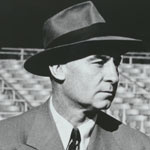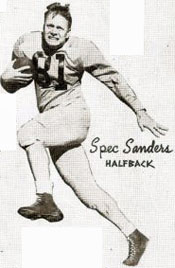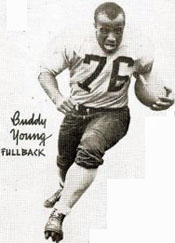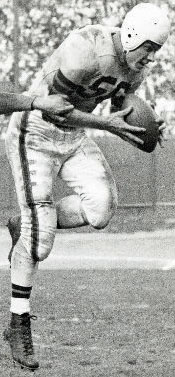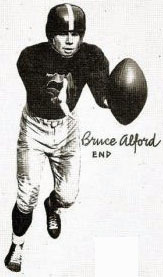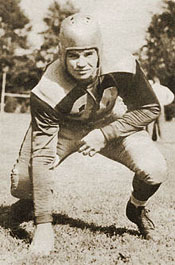Note: The gray boxes contain asides that provide interesting material but could be skipped without losing the continuity of the article.
|
|
When the All-American Football Conference ended its successful first season in 1946, football fans began clamoring for an NFL-AAFC championship game.
All eight AAFC franchises returned for the '47 season. However, the two 1946 division winners dominated play again.
The New York Yankees, coached by NFL veteran Ray Flaherty, won the battle of New York City over the Giants of the NFL not only on the field but also at the box office.
You can guess which AAFC team topped the Yankees in both points scored and allowed.
So it was inevitable - and fitting - that the Browns return to Yankee Stadium three weeks after the 28-28 tie to determine the AAFC championship. 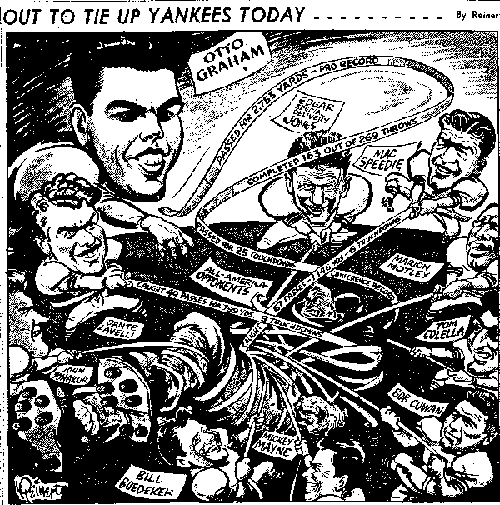 Cleveland Plain-Dealer cartoon day of championship game Some pegged the clash as pitting the team with the superior aerial attack (Cleveland) against the foe with the better running game (Yankees).
The weather forecast called for a high temperature of 40 with cloudy skies.
|


1947 New York Yankees
|
|
- The weather turned up about as expected with the high in the low 40s.
- When the tarpaulin was removed, the field looked sleek and perfect. But the infield portion, in shadow throughout the winter, was frozen solid.
- The field, flecked with ice and snow, remained slippery, a condition that probably hurt the Yankees more than the Browns since the home team relied more on the running game. The end of the field in the shadow of the grandstand was frozen on top while the outfield end was wet on top from frozen ice.
- Louis Efrat of the New York Times described the field conditions like this: Time and again a man slipped at a vital instant. It was next to impossible for anyone to cut sharply, nullifying much of the effectiveness of the players. As a result, most of the pass-catching was by stationary receviers. Furthermore, the defense was as heavily taxed as the offense.
- Writers in the pressbox wondered why the teams didn't wear sneakers. The Browns had brought their supply with them. Later, it was learned that the two coaches had agreed before the game that the players would wear only regulation cleats. Flaherty said, Sneakers would not have done much good - the field was that bad.
- The attendance didn't reach the anticipated 70,000, but the 61,879 figure still qualified as the largest ever for a pro football playoff contest.
- 4,000 of the assemblage came from Cleveland, including a delegation led by Mayor Thomas A. Burke. Bill Veeck, president of the baseball Indians, also was present.
- Other notable onlookers were baseball Commissioner "Happy" Chandler and tennis champion Jack Kramer.
On the field before the kickoff, Brown called over Motley. Marion, you see all those people out there? Guess what they're here for. The big FB gave the obvious answer - to see a football game. No, Marion, Brown replied, the thing they want to know is whether you or Buddy Young is a better man.
Ever the master motivator, Paul knew that his best chance to win against a tough defense on a treacherous field was to emphasize Motley's running interspersed with short, quick passes.
Like the '46 championship game, the defenses prevailed from the beginning.
- Quarter 1
The Yankees received the kickoff, and it was obvious right away that the Browns D was determined to play better than they did in the 28-28 tie. They deployed their tackles head-on the offensive ends. The system closed the gaps that were so open in the previous game. Another surprise for the Yanks was little-used sub QB Cliff Lewis starting in the defensive secondary.
After gaining only 3y on three plays even with an offside penalty against the Browns, including two errant Spec Sanders' passes, the home team punted.Graham kept warm during the game by tossing to a teammate on the sidelines when the Yankees had the ball.
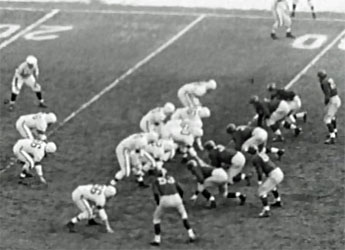
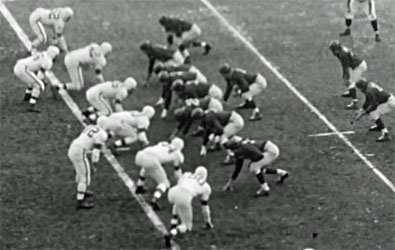
The Browns T-formation vs the Yankees single wing
For the Yanks, TB Spec Sanders has his elbows on his knees with Buddy Young to his right.
On first down, Graham straightened up and hit Speedie for only 3y. Then Otto flipped a long lateral to Motley. The giant FB sped through RT, cut toward the middle of the field, then headed for the sidelines again. He got past everyone except DB Harmon Rowe who closed in and nicked Marion's feet, causing the ball carrier to stumble out of bounds at the NY 13 to complete the 51y jaunt.


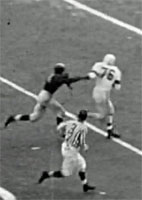
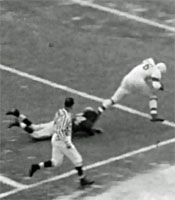
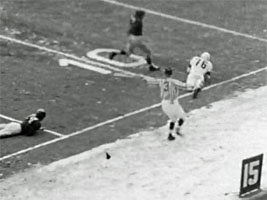
Motley's 51y run from freend zonee frame images from the video of the game
 Graham hits Speedie. 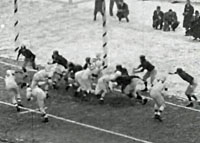 Graham sneaks over. 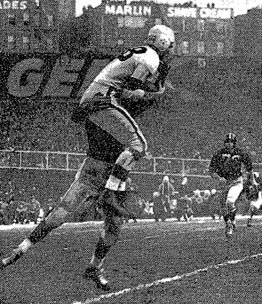 Mac Speedie catches a pass as Rowe hits him. |
Graham tried another first down pass, but Alford intercepted. However, the Yanks were penalized for defensive holding. Jones made a yard, but Mayne was held without gain. So on third down, Graham passed to LE Speedie cutting across the middle. Mac made a leaping catch amid three defenders, who wrestled him down at the 1. Graham pushed into the snow-covered end zone on a QB sneak. Lou "The Toe" Groza converted. Browns 7 Yankees 0
|
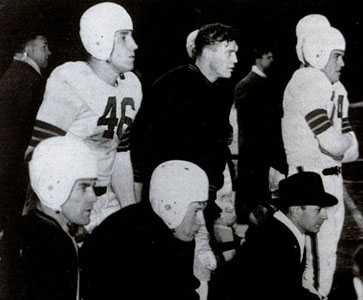
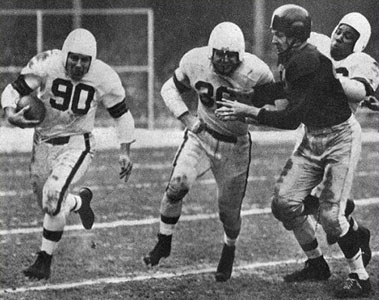
L: Shivering Otto Graham (far right), Coach Brown (lower right), Lou Groza (46), and other Clevelanders watch the action
R: Edgar "Special Delivery" Jones sweeps behind guards Ed Ulinski and Bill Willis
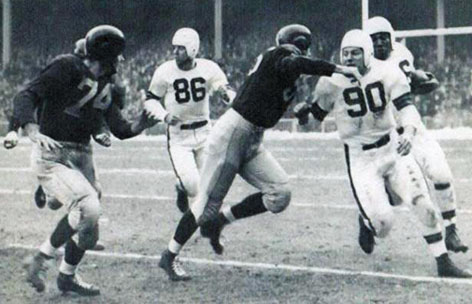
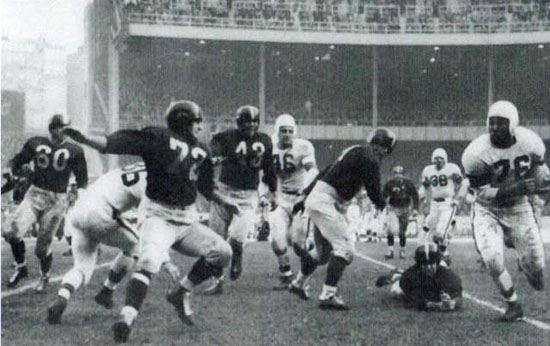
L: Marion Motley runs behind Jones as Charlie Riffle and Harmon Rowe move in.
R: Motley tries to sweep as Lloyd Cheatham (60), Eddie Prokop (72), and Ted Ossowski (43) pursue.
- Quarter 3
A short pass and two runs gave the Browns a first down at their 32. Motley then bounced off tacklers to the 42 to move the chains again. The crowd roared when Graham, back to pass, was hit and fumbled on his 35 and Bruce Alford recovered. But the referee ruled the whistle had blown, and the Browns retained possession. The slippery conditions were illustrated on the next few plays. First, the halfback going in motion lost his footing and ended up on his backside as Motley was stuffed. After a holding penalty set Cleveland back, Jones gained most of the yardage back on a gingerly run around RE to the 29. But on 3rd down Graham fell not once but twice as he tried to pass. So Gillom punted, and the Browns illustrated their soundness in all phases of the game. Young took the ball on one big hop, tried to go right, then ran left, slipping away from several tacklers until he gained 1y to the 28.
After two runs and a long pass gained nothing, Cleveland gained 34y on the punt exchange when Kennedy's boot sailed out of bounds on the NY 43.
But the visitors didn't take advantage of the break immediately. On the first play, Jones fumbled after catching a pass, and Lloyd Cheatham recovered for the Yanks on their 37.
But New York gave the ball right back on the next play when DB Tommy Colella made a shoestring INT of Sanders' jump pass and returned it 14y to the NY 41.
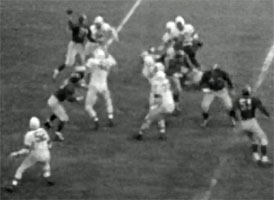
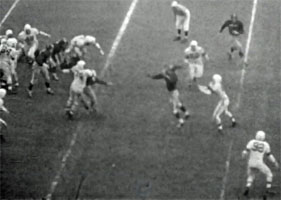
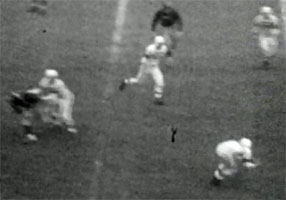
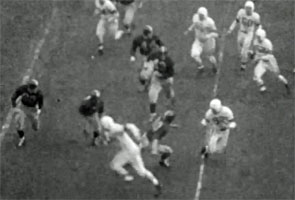
Tommy Colella intercepts Spec Sanders' overthrown jump pass.
Young finally got a good kickoff return to the 41. Confident their DBs could cover the receivers, the Browns put eight men in the box, five down linemen and three LBs. The move paid dividends immediately as Sanders lost the good field position when he tried to pass but was swarmed under by a gang of Browns led by Chet Adams for a 13y loss. A Young run and a failed pass led to a punt, and Cleveland started from their 31.
But three plays gained only 3y. So Gillom punted out of bounds on the NY 30.
Sanders connected with E Van Davis running open down the middle to the 46. Young found running room at LT to the Cleveland 43. Next, Buddy took a direct snap but stumbled back to the line of scrimmage as the clock ran out.
Browns 14 Yankees 3
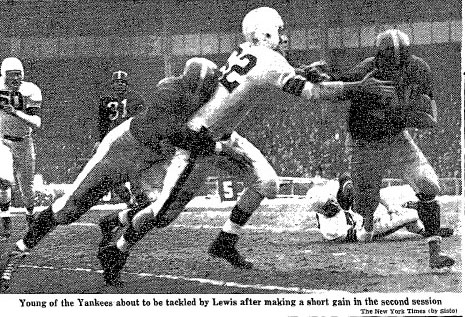
- Quarter 4
The field lights illuminated the final 15 minutes.
The Yankee drive continued with Sanders hitting Russell running across the field. Jack ran untouched until he slipped down at the 23. Then an offside penalty against the Browns put the ball on the 18. But on the next snap, disaster struck. Young dropped a long lateral pass, fell on the ball but lost control of it, and Saban ended up with it on the 30.
Two runs and a pass to Speedie gained only 8y. So Gillom continued his good punting (45.0 average for the day), Young returning 5y to the 26.
The respite hadn't cooled off the Yanks offense. On 3rd-and-2, Sanders got off his best run of the day to the Browns 44. After two short runs, Young got away for 13 more, but the officials spotted Rowe swinging a left hook at Colella. That cost NY not only the gain but also 15y for unnecessary roughness back to their 43. Colella demonstrated remarkable coolness in the situation, not giving in to the temptation to strike back. After an incompletion, Sanders lost seven, and Kennedy punted to the 23.
With the defense massed to stop the run, Graham started with a quick pass to Speedie for five. After Motley gained 0, Otto hit Colella just short of the first down marker. After a delay of game penalty, Gillom barely got his boot off, the pigskin going out on the NY 25.
With the sun and their hopes setting, the Yankees started promisingly with a quick pass out left to the man in motion, Young, who ran to the 37. Spec tried the same play to the other side, and it worked there also. Buddy slipped and slid to midfield. But as happened all afternoon, the home team couldn't sustain the momentum, and Kennedy punted to the 9 - a strange decision since only a few minutes remained.
Sticking to the ground to run out the clock, Graham handed to Jones twice to the 24 and Mayne once to seal Cleveland's second straight championship.
BROWNS 14 Yankees 3 .
- Thousands of rooters from Harlem swarmed on the field after the game, surrounding Motley, Gillom, and Bill Willis, the Browns' three African-American players and delaying their exit from the field. Some hoisted Motley on their shoulders - quite a feat - and carried him halfway to the locker room.
- The game marked the first time in 19 contests that Sanders was kept out of the end zone and only the second time in the two years of the AAFC that the Yankees failed to score a touchdown, the Browns turning the trick both times.
- First downs: Browns 15 Yankees 13
- Yards rushing: Browns 33-172 , Yankees 33-123
- Passing: Browns 21-14-0/112, Yankees 18-7-1/89
- Fumbles-Lost: Browns 2-1, Yankees 3-2
- Penalties: Browns 7-45,Yankees 3-21

New York Times cartoon the day after the game
- There was little excitement in the Browns' dressing quarters. Only a few cheers, mostly from scrubs with nice clean suit, marked the occasion. It seemed as if this championship stuff was already old hat to them.
- Coach Brown climbed onto a trunk and shouted: Great, great, great! Well, we beat them because we played together. Did you ever see any team pull together like ours out there? No fussing no agruments. We played football like we knew we'd win. Congratulations. And listen, just as a special memento, keep your jackets.
- Brown to reporters: It was tough, a real narrow squeak. Conditions were bad; that field made it like ice skating, and we couldn't run very well. Our passing got us by; it did the trick.
Neither team could play its best on that field. ... However, we tried to take advantage of the conditions by creating one-against-one situations on our pass patterns, and this worked pretty well on Otto Graham's flat tosses.
Asked to name the standouts for the game, Brown replied, Gee whiz. Motley was superb. And Young can really go with that football. He just squirts through there.
Are you excited at winning? Gosh now. But say, what was the final score? - Browns T coach Bill Edwards praised the courageous performance of Chet Adams. He turned in the finest exhibition of defensive play I have witnessed by him this year. He had a lot to do with stopping those rushes by Spec Sanders and Buddy Young. The guy deserves a lot of credit for the courage he demonstrated by coming back after injuring his neck again. Kudos also went to Blandin, who took a defensive turn with his bad ankle to give Adams a chance to recuperate.
- Flaherty: We thought about covering the field this week with hay to keep it from freend zoneing. We didn't, and so our ground attack bogged down. I can't overemphasize how much that slick footing cost us. ... We'll keep after 'em, and we'll get 'em yet. However, I do wish the field had not been so bad for Spec and Buddy.
- Young, who fumbled twice, was asked what he would do now that the season was over. Keep in shape, and learn to hold on to a football.
The players split $209,820, which was the second largest in pro history to only the 1946 NFL title game between the Bears and Giants at the Polo Grounds ($282,955).
- The Browns took home $1,191.99 each for their afternoon's work.
- Each Yankee earned $794.66, a hefty addition to each man's salary.

When All the World Was Browns Town, Terry Pluto (1997)
Paul Brown: The Rise and Fall and Rise Again of Football's Most Innovative Coach, Andrew O'Toole (2008)
Top of Page
